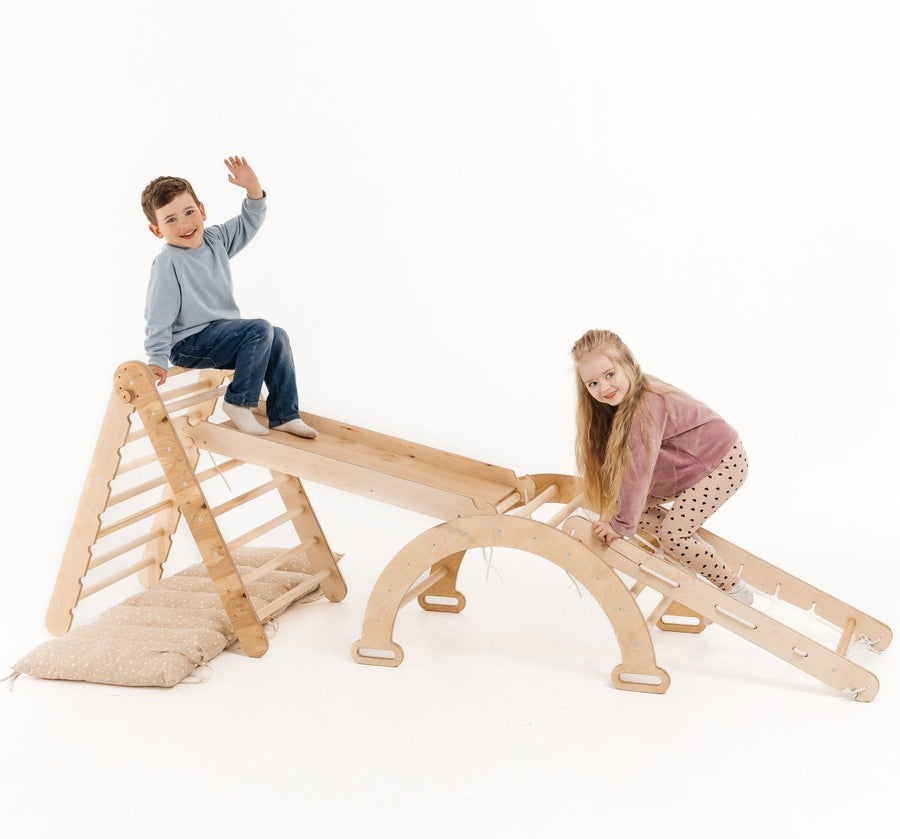Igniting Growth with Montessori Toys: A Journey into Motor Skills and Coordination
Introduction to the World of Montessori
Welcome to this comprehensive guide, dedicated to uncovering the magic of Montessori toys and their role in nurturing your child's motor skills and movement coordination!

Source: Apsva.us
In this article, we'll delve into the Montessori philosophy, a child-centred educational approach that has transformed early childhood learning landscapes worldwide.
We will also unpack the distinctive features of Montessori toys, highlighting their stark differences from traditional toys. You will discover their deliberate simplicity, the emphasis on natural materials, their alignment with specific skill sets, and the deep sense of purpose each one carries.
The spotlight will then turn onto the importance of motor skills and movement coordination in early childhood. We will explore the categories of motor skills – fine and gross, their implications for a child's growth, and the role of movement coordination in daily activities.
Diving deeper into the Montessori toy approach, we will investigate how tools such as swings, Swedish walls, and Pikler triangles can ingeniously nurture motor skills and coordination, turning playtime into a wellspring of developmental milestones.
Finally, we'll walk you through a practical guide to selecting the right Montessori toys, taking into account your child's age, developmental stage, and interests, and the importance of choosing quality over quantity.
By the end of this article, you'll be well-equipped with knowledge and insights to optimise your child's play environment, setting the stage for their motor skill and movement coordination development – all while keeping play engaging and fun. Welcome to the world of Montessori :)
Understanding the Montessori Philosophy

Source: Trimontessori.org
The Montessori Philosophy is a unique, child-centred educational approach, founded by Dr. Maria Montessori. The philosophy rests on the fundamental belief that children are naturally eager for knowledge and capable of self-directed learning when placed in an appropriately ‘prepared environment’. Montessori emphasises hands-on, experiential learning, and encourages children to engage with tasks that capture their interest, cultivating a love for lifelong learning.
An essential element of Montessori philosophy is the belief in the 'absorbent mind'—the idea that children from birth to age six possess limitless motivation to achieve competence within their environment and to perfect skills and understandings. This innate curiosity and drive to learn make this period an optimal time for children to interact with their environment, including people and materials, and learn from these interactions.

Source: Additioapp.com
The philosophy also promotes the development of the whole child—physical, social, emotional, and cognitive. This is achieved by providing children with activities that cater to their individual needs and development stages. Each Montessori classroom, or prepared environment, is filled with materials and activities designed to cultivate cognitive skills, sensory awareness, language acquisition, fine and gross motor development, and practical life skills. Children are granted the freedom within boundaries to explore, learn and grow at their own pace, fostering their independence, confidence, and intrinsic motivation.
In essence, the Montessori Philosophy sees the child as the one who makes the man, as a being of great worth and dignity, deserving of respect, and capable of self-realisation through interaction with their environment. As a parent, understanding this philosophy empowers you to create a nurturing environment that promotes the full development of your child, laying a strong foundation for their future learning and growth.
Explaining how Montessori Toys are Different to Traditional Toys
One of the distinguishing traits of Montessori toys is their simplicity. Free from loud noises, flashy lights, or complex features often found in conventional toys, Montessori toys encourage children to interact with their simplicity, fostering concentration and creative thinking. They are intentionally minimalistic, keeping a child's focus on the task at hand.
Montessori toys are skill-focused. Rather than overwhelming children with multiple functions, each toy targets a specific developmental stage or skill set. From puzzles designed to enhance fine motor skills to blocks promoting spatial awareness, these toys offer opportunities for self-directed, meaningful play.

Source: Nymag.com
Another crucial element is that Montessori toys are made with natural, high-quality materials such as wood or fabric, often handcrafted. This is not just an aesthetic choice, but a reflection of the Montessori belief in providing children with real-life experiences. The textures, weights, and smells of natural materials offer richer sensory experiences and help children develop a deep respect for their environment.
Perhaps the most significant factor that sets Montessori toys apart is their purposefulness. They are designed to stimulate children's innate curiosity and help them learn at their own pace. Each toy is thoughtfully crafted to encourage exploration, problem-solving, and independence, setting the groundwork for a lifelong love of learning.
The importance of motor skills and movement coordination in early childhood
The development of motor skills and movement coordination in early childhood is pivotal to a child's overall growth, not only in the physical realm but also in their cognitive and socio-emotional development. It's like building the scaffolding for a child's journey towards becoming an active, competent and confident individual.

Source: Healthline.com
Motor skills can be broadly categorised into two types: fine and gross. Fine motor skills involve the use of smaller muscle groups for tasks like picking up small objects, tying shoelaces, or drawing. Gross motor skills, on the other hand, engage larger muscles for activities such as crawling, walking, jumping, and throwing. Both sets of skills are crucial for a child's autonomy and the ability to navigate the world around them.
As children learn to control their movements, they gain a sense of independence, a crucial aspect of self-esteem and self-efficacy. Activities that promote motor skills also foster problem-solving, as children must learn to adapt their movements to achieve a desired result. This can be as simple as figuring out how to reach a toy or as complex as navigating a playground.
Movement coordination, the ability to execute smooth and efficient motions, also plays a crucial role. Coordination is key to many daily activities such as dressing, eating, and more sophisticated tasks like playing a musical instrument or participating in sports.
Nurturing Motor Skills and Movement Coordination: The Montessori Toy Approach
The Montessori method, steeped in respect for a child's natural growth and desire for learning, extends a distinct approach towards nurturing motor skills and movement coordination. This strategy is beautifully embodied in the design and usage of Montessori toys.
To start, swings are an exciting way of introducing infants and toddlers to the concept of movement. The motion of swinging assists in refining a child's sense of balance and spatial orientation, skills that are critical in all physical activities. As they strive to maintain equilibrium while swinging, they're unwittingly honing their coordination, developing a keen sense of their bodies in space. Additionally, swings help in building muscle strength, particularly in the core and the legs. This muscular development further fuels the refinement of both gross and fine motor skills, enhancing a child's capacity to engage in a variety of physical activities.

Source: Goodevas.com
A Swedish wall is another notable Montessori tool that encourages a child’s physical development. This wall-mounted ladder, often fitted with various elements like climbing ropes and monkey bars, offers a safe environment for children to explore their strength, flexibility, and fear boundaries. Climbing and manoeuvring through a Swedish wall aids children in refining their gross motor skills, improving spatial awareness, and building a healthy relationship with physical challenges.

Source: Goodevas.com
The Pikler Triangle, a climbable wooden structure, is an essential Montessori toy that promotes exploration and independent physical play, fostering self-confidence and gross motor development. As a child climbs, they're not merely exercising their limbs; they're learning about their body's capacities, its limitations, and the physics of their movement. It’s also a tool for teaching risk management, as children learn to navigate the heights safely and on their terms. For a deeper exploration of the Pikler Triangle and its multitude of benefits, we invite you to visit this link. It will guide you to another insightful article in our collection, providing you with a comprehensive understanding of this remarkable Montessori toy.

Source: Goodevas.com
Choosing the Right Montessori Toys: A Buyer's Guide
Firstly, consider the child's age and developmental stage. Montessori toys are designed to align with specific growth phases, focusing on appropriate skill sets. For infants and young toddlers, opt for toys that encourage basic grasp reflex and hand-eye coordination. As children grow, look for toys that challenge their fine motor skills, such as threading beads or puzzles, and gross motor skills like climbing structures or balance boards.

Source: Goodeavs.com
Secondly, take into account the child's interests. One of the fundamental Montessori principles is 'follow the child,' which means acknowledging their unique inclinations. If a child is drawn towards music, consider rhythmic instruments. If they enjoy movement, a swing or Swedish wall will be perfect for your little ones. By aligning toys with interests, you're more likely to engage the child in meaningful, enjoyable play.

Source: Insider.com
Next, look for versatility and longevity in your choice. Good Montessori toys can adapt to a child's changing needs, remaining relevant across various developmental stages. Building blocks, for example, can be used for stacking in early years and for complex structures as the child grows.
Finally, always prioritise quality over quantity. Montessori philosophy advocates for fewer, purposeful toys over an overwhelming assortment. Ensure the toys are made of safe, durable materials that can withstand the test of time and exploration.
Final Thoughts
Embracing the Montessori philosophy means recognizing the boundless potential within every child, and equipping them with the tools necessary to explore, learn, and grow at their own pace. As we've journeyed through this guide, we've highlighted the importance of motor skills and movement coordination in early childhood development, and how carefully selected Montessori toys can seamlessly integrate skill development into play. From swings that teach balance, Swedish walls that challenge strength and flexibility, to Pikler triangles that foster risk assessment and gross motor skills, each of these toys carries a purpose, designed to fuel your child's curiosity and learning.
Expanding on the wisdom of O. Fred Donaldson's statement, "Children learn as they play. Most importantly, in play children learn how to learn," the unique essence of Montessori toys comes to the fore. Montessori toys are not just playthings, they are tools that scaffold self-directed learning in children. They're intentionally designed to be simple and purposeful, inviting children to engage, explore and experiment in a way that feels like play but serves as a significant learning experience.
However, the most profound learning that takes place is meta-learning – learning about the process of learning itself. As children manipulate these toys, make mistakes, experiment, and finally succeed, they are gaining insights into their learning style, their pace, their strengths, and areas they need to work on. They're learning to learn – a skill that will hold them in good stead throughout their lives. So, let's embrace Montessori toys as the invaluable learning tools they are, nurturing our children's development in the most natural, joyful way – through play!
References:
- “What is the Montessori method and how does it work” (2021) https://additioapp.com/en/what-is-the-montessori-method-and-how-does-it-work/
- Lillard, Angeline (2007) “Montessori: The science behind the genius”. Oxford University Press.
- Berk, Laura E. (2012) "Child Development," Pearson.
- Gallahue, David L. and Ozmun, John C. (2006) "Understanding Motor Development: Infants, Children, Adolescents, Adults," McGraw-Hill.
- Stork, Susan and Garrison, Lesley (2011) “Motor Skills Acquisition in the First Year: An Illustrated Guide to Normal Development,” Jones & Bartlett Learning.
- Eliot, Lise (2000) “What's Going On in There?: How the Brain and Mind Develop in the First Five Years of Life,” Bantam Books.






Hinterlassen Sie einen Kommentar